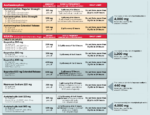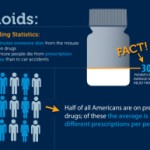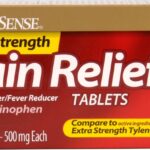NSAIDs are a group of drugs used to temporarily relieve pain and inflammation. They work by blocking the production of prostaglandins, or chemicals believed to be associated with pain and inflammation. Nonsteroidal anti-inflammatory drugs (NSAIDs) are available by prescription and over-the-counter (OTC).

They are used to relieve fever and pain, such as those associated with headaches, colds, flu, and arthritis. Examples of prescription NSAIDs include ibuprofen, naproxen, diclofenac, and celecoxib. Ibuprofen and naproxen are also available OTC at lower strengths.
What are non-selective NSAIDs and COX-2 selective NSAIDs?
Non-selective NSAIDs work by inhibiting two enzymes that are involved with inflammation—cyclooxygenase-1 and cyclooxygenase-2 (COX-1 and COX-2).
There are several non-selective NSAIDs on the market, including diclofenac, ibuprofen, ketoprofen, meloxicam, naproxen, and oxaprozin. Ibuprofen and naproxen are available in both prescription and over-the-counter (OTC) versions. The doses in OTC NSAIDs are lower than the doses of prescription versions and should only be used for up to 10 days without seeing a doctor. So, if you take OTC ibuprofen (Advil and Motrin) or naproxen (Aleve), the doses are about half the doses of prescription versions.
COX-2 selective inhibitors are a newer type of medicine that block the COX-2 enzyme more than the COX-1 enzyme. The only COX-2 selective inhibitor currently on the market in the United States is the prescription drug Celebrex (celecoxib), which is marketed by Pfizer. It was believed that COX-2 inhibitors may be less likely to cause the stomach problems associated with the older NSAIDs, but all NSAIDs carry the risk of stomach problems.
What are the risks of taking NSAIDs?
As with all drugs, there is the potential for an allergic reaction to NSAIDs. Symptoms might include hives, facial swelling, wheezing and skin rash.
There is the potential for gastrointestinal bleeding (bleeding in the stomach or elsewhere in the digestive tract) associated with all NSAIDs. The risk of bleeding is low for people who use NSAIDs intermittently. The risk of stomach problems goes up for people who take them every day or regularly, especially for people who are older than 65, people with a history of stomach ulcers, and people who take blood thinners or corticosteroids (prednisone). Alcohol use can also increase the risk of stomach problems.
In addition, using all NSAIDs, except for aspirin, increases the risk of heart attack or stroke. These serious side effects can occur as early as the first few weeks of using an NSAID, and the risk might rise the longer people take non-aspirin NSAIDs.
All NSAIDs also carry the risk of potential skin reactions. Patients should be alert for symptoms such as skin reddening, rash or blisters.
Aspirin is a non-selective NSAID and has been shown in clinical trials to reduce the risks of certain cardiovascular events in patients who have cardiovascular disease or who have already had a heart attack or ischemic stroke. Aspirin is sold in generic forms and under brand names such as Bayer and St. Joseph’s.
Which people are at highest risk for cardiovascular adverse events associated with NSAIDs?
People who have cardiovascular disease—particularly those who recently had a heart attack, cardiac bypass surgery or stroke—are at the highest risk for adverse events. According to studies, people who have already had a heart attack are at an increased risk of having another heart attack or dying of heart attack-related causes if they’re treated with NSAIDs, other than aspirin.
Which Cox-2 selective inhibitors have been taken off the market?
A. Merck voluntarily withdrew Vioxx (rofecoxib) in 2004 after finding out the results of a study that showed patients who took Vioxx had a higher risk for heart attacks than patients who took a placebo. FDA asked Pfizer to withdraw Bextra (valdecoxib) from the market in 2005 because the overall risk/benefit profile was unfavorable. The request was based on many factors. Along with the other risks associated with NSAIDs, there was a higher than expected number of reports of serious and potentially life-threatening skin reactions, including death.
An increased risk of cardiovascular adverse events has been shown for all COX-2 inhibitors, including Celebrex, which is still on the market in the United States. Based on available data, FDA determined that the benefits of Celebrex outweigh the potential risks in properly selected and informed patients. FDA asked Pfizer to include a boxed warning on the Celebrex label, and asked manufacturers of all prescription NSAIDs to revise their labeling with a boxed warning too. The boxed warning highlights the potential for increased risk of cardiovascular events as well as serious, potentially life-threatening gastrointestinal bleeding. It is important to know that FDA also determined that the risk for cardiovascular events was most likely present for the non-selective NSAIDs as well, and all of the manufacturers of these drugs were asked to add important warnings to their labels.
What can consumers do to lower their risks with NSAIDs?
Tell your doctor about your complete medical history, including any history of cardiovascular disease or stomach ulcers. This will help you and your doctor weigh the risks and benefits. You can also ask your doctor what you can do to lessen the chance for stomach irritation such as taking medication with a meal. Also, ask what steps you can take to lower the risk of cardiovascular disease and report medication side effects to your doctor. Whether you’re taking a prescription NSAID or an OTC NSAID, following directions is important. Available scientific data don’t suggest an increased risk of serious cardiovascular events for short-term, low-dose use of OTC NSAIDs, but it is not known if that is because there is no risk or because there are many challenges when trying to study the use of OTC NSAIDs. Be aware that the OTC labeling states that if you take an NSAID for longer than 10 days, you should see your doctor. The lowest effective dose should be used for the shortest time.
What conditions do NSAIDs treat?
Prescription NSAIDs are important to help manage many debilitating conditions such as osteoarthritis and rheumatoid arthritis. Some prescription NSAIDs also are used to treat pain. Over-the-counter versions of some NSAIDs are used to treat pain associated with dental problems, tendonitis, strains, sprains and other injuries. NSAIDs are also commonly used to treat fever and to reduce pain associated with menstrual cramps.
How many NSAIDS approved in Unisted States ?
- aspirin
- celecoxib (Celebrex)
- diclofenac (Cambia, Cataflam, Voltaren-XR, Zipsor, Zorvolex)
- diflunisal (Dolobid – discontinued brand)
- etodolac (Lodine – discontinued brand)
- ibuprofen (Motrin, Advil)
- indomethacin (Indocin)
- ketoprofen (Active-Ketoprofen [Orudis – discontinued brand])
- ketorolac (Toradol – discontinued brand)
- nabumetone (Relafen – discontinued brand)
- naproxen (Aleve, Anaprox, Naprelan, Naprosyn)
- oxaprozin (Daypro)
- piroxicam (Feldene)
- salsalate (Disalsate [Amigesic – discontinued brand])
- sulindac (Clinoril – discontinued brand)
- tolmetin (Tolectin – discontinued brand)
What are the side effects of NSAIDs?
NSAIDs are associated with several side effects. The frequency of side effects varies among NSAIDs.
Common side effects are
- nausea,
- vomiting,
- diarrhea,
- constipation,
- decreased appetite,
- rash,
- dizziness,
- headache, and
- drowsiness.
Other important side effects are:
- kidney failure (primarily with chronic use),
- liver failure,
- ulcers, and
- prolonged bleeding after injury or surgery.
NSAIDs can cause fluid retention which can lead to edema, which is most commonly manifested by swelling of the ankles.
Pain Medications, Pain Relief, and Pain Management








